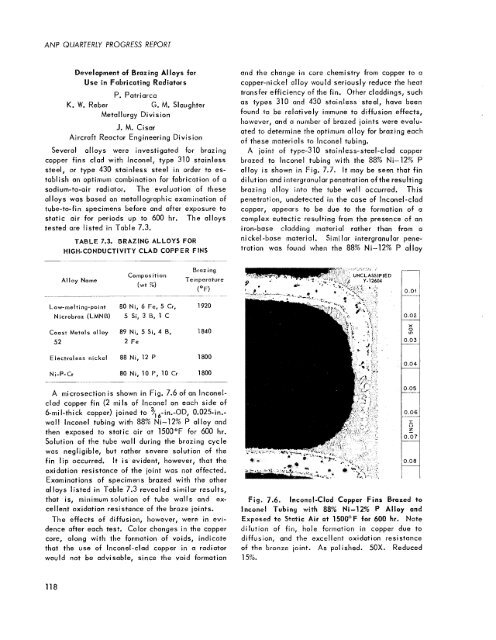ORNL-1771 - Oak Ridge National Laboratory
ORNL-1771 - Oak Ridge National Laboratory
ORNL-1771 - Oak Ridge National Laboratory
You also want an ePaper? Increase the reach of your titles
YUMPU automatically turns print PDFs into web optimized ePapers that Google loves.
ANP QUARTERLY PROGRESS REPORr<br />
Development of Brazing Alloys for<br />
Use in Fabricating Radiatars<br />
K. W. Reber<br />
P. Patriarca<br />
G. M. Slaughter<br />
Metallurgy Division<br />
J. M. Cisar<br />
Aircraft Reactor Engineering Division<br />
Several alloys were investigated for brazing<br />
copper fins clad with Inconel, type 310 stainless<br />
steel, or type 430 stainless steel in order to es-<br />
tablish an optimum combination for fabrication of a<br />
sodium-to-air radiatoi. The evaluation of these<br />
alloys was based on metallographic examination of<br />
tube-to-fin specimens before and after exposure to<br />
static air for periods up to 600 hr. The alloys<br />
tested are listed in Table 7.3,<br />
TABLE 7.3. BRAZING ALLOYS FOR<br />
HIGH-CONDUCTIVITY CLAD COPPER FBNS<br />
Saazing<br />
Composition<br />
Alloy Name Temperature<br />
(wt %I<br />
. . . . . . . . . .<br />
~~ ~....~<br />
(Or=)<br />
__ ..... . .-~.<br />
Low-melting-point 80 Ni, 6 Fe, 5 Cr, 1920<br />
Nicrobraz (LMNB) 5 Si, 3 B, 1 C<br />
Coast Metals alloy 89 Ni, 5 Si, 4 €3, 1840<br />
52 2 Fe<br />
Electroless nickel 88 Ni, 12 P 1800<br />
Ni-P-Cr 80 Ni, 10 P, 10 Cr 1800<br />
A microsection is shown in Fig. 7.6 of an lnconelclad<br />
copper fin (2 mils of lnconel on each side of<br />
6-mil-thick copper) ioined to 3 /,6-in.-OD, 0.025-in.-<br />
wall Inconel tubing with 88% Ni-12% P alloy and<br />
then exposed to static air at 1500°F for 600 hr.<br />
Solution of the tube wall during the brazing cycle<br />
was negligible, but rather severe solution of the<br />
fin lip occurred. It is evident, however, that the<br />
oxidation resistance of the joint was not affected.<br />
Examinations of specimens brazed with the other<br />
alloys listed in Table 7.3 revealed similar results,<br />
that is, minimumsolution of tube walls and ex-<br />
cellent oxidation resistance of the braze joints.<br />
The effects of diffusion, however, were in evi-<br />
dence after each test. Color changes in the copper<br />
core, along with the formation of voids, indicate<br />
that the use of Inconel-clad copper in a radiator<br />
would not be advisable, since the void formation<br />
118<br />
and the change in core chemistry from copper to a<br />
copper-nickel alloy would seriously reduce the heat<br />
transfer efficiency of the fin. Other claddings, such<br />
as types 310 and 430 stainless steel, have been<br />
found to be relatively immune to diffusion effects,<br />
however, and Q number of brazed joints were evalu-<br />
ated to determine the optimum alloy for brazing each<br />
of these materials to Inconel tubing.<br />
A joint of type-310 stainless-steel-clad copper<br />
brazed to lnconel tubing with the 88% Ni-12% P<br />
alloy is shown in Fig. 7.7. It may be seen that fin<br />
dilution and intergranular penetration of the resulting<br />
brazing alloy into the tube wall occurred. This<br />
penetration, undetected in the case of Inconel-clad<br />
copper, appears to be due to the formation of a<br />
complex eutectic resulting from the presence of an<br />
iron-base cladding material rather than from a<br />
nickel-base material. Siini Iar intergranular pene-<br />
tration was found when the 88% Ni-12% P alloy<br />
UNCLASSIFIED<br />
0.02<br />
Fig, 7.6, Inconel-Clad Copper Fins Brazed to<br />
Inconel Tubing with 88% Ni-12% P Alloy and<br />
Exposed to %tic Air at 1500° for BOO hr. Note<br />
dilution of fin, hole formation in copper due to<br />
diffusion, and the excellent oxidation resistance<br />
of the bronze joint. As polished. 50X. Reduced<br />
1.5%.<br />
.



![Review of Molten Salt Reactor Physics Calculations [Disc 2]](https://img.yumpu.com/21979492/1/190x247/review-of-molten-salt-reactor-physics-calculations-disc-2.jpg?quality=85)













